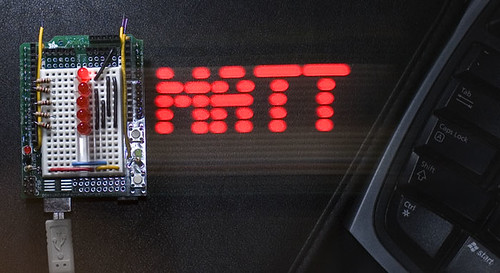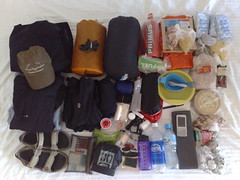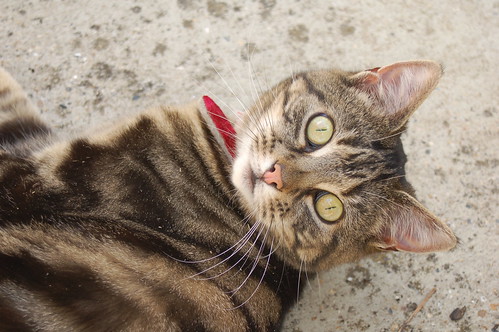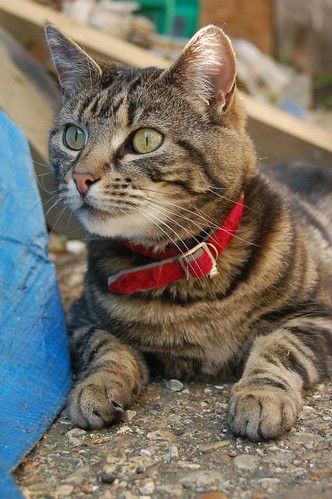The further parts in this series of posts can be found here:
part 2
To celebrate/commiserate (delete as appropriate) moving on from four and a half years of employment at
Symbian and then
Nokia I've decided to try my hand at writing a mobile application.
The first step in writing an application is deciding what to write. This is harder than it sounds as there are already quite a range of applications out there, both for the
Symbian platform and for other
mobile platforms. While there is nothing wrong with creating an application which has already been done, especially if you have a new and unique take on it, but you do have to ask yourself if the world really needs another
glass of beer simulator.
After some thought I realised that I wanted to try to create a simple
persistence of vision (PoV) application. The basic idea with PoV is that in trying to make sense of the world, your brain merges together what your eyes see over a short period of time. This has been exploited to write messages in empty space.

This is typically done with a row of LEDs (as in the above example) and a small micro-controller like an
Arduino such as in the example above or
like this.
While I have dabbled in hardware before, I'm primarily a software person and as I was looking for a small mobile application to try writing, I thought a PoV application would be an ideal starting point. It's a fairly simple application which using a mobile phone has some extra possibilities, such as higher resolution (so better quality images) and more colours. I don't, however, foresee any practical use for it aside from perhaps using it to send multi-colour messages across a
dark and noisy room.
Doing a PoV application also had the advantage that I could start small and add new features easily. This is very important for all software projects, whether developed as part of your job or just for fun. If it takes you a year of writing to create something which you would be proud to show people then you are quickly going to lose motivation and stop caring. Put simply, I wanted regular and meaningful milestones (or key points) where I could point at something that I could be pleased to have created. I think that this is an important aspect for any project, be it software or building a shed in your garden, human beings seem to work best when they have regular goals which they get clear feedback when they've achieved.
In my mind two lists formed as a consequence of this. The first list was a list of things that I'd need to do to get the first version done. This list needs to be short so that I can easily achieve it. The second list was a list of possible future ideas. This list needs to be long enough for me to have some interesting features to add to the application.
First version features:
- Take some text as input.
- Display it in a set time period.
Future ideas:
- Accelerometer support - so it knows when to start displaying the message.
- Colour selection - more than the plain LED red of hardware PoV.
- Multi-coloured messages - because rainbow text would be awesome.
- Image painting - is it possible to paint more than a single line of text in the air?
Happily the PoV application idea satisfied both criteria, having only two things to do in the first version and a number of varied things to do in the future.
So that's is the first hurdle passed in software development; but knowing what I was going to write was worthless if it didn't have a name. Names are very important, especially for software projects. Some schools of thought subscribe to the theory that the name is
the most important thing about a project. I wouldn't go that far, but a good name is the first step in creating a good application. It's also a case with naming that thinking about it for too long, or being too clever about it, leads to a worse name. Not wanting to pick on Google in particular, but the first example of this that came to my mind was when Google decided to rename 'Froogle' to 'Google Product Search'. They renamed it as the
pun on the word frugal in the name wasn't obvious.
Immediately I decided that using the term PoV was a big no-no. I always read PoV as Point of View unless something about the context indicates that it's probably Persistence of Vision. If I, as someone who knows and understand the term, doesn't find it immediately conjuring up visions of text in the air then what hope has anyone else got? So my thought turned to other names and one which lead on almost directly from the anti-PoV viewpoint was to call it 'SkyWriter'.
The name SkyWriter does almost exactly what it says on the tin and so seemed like a good name. Before getting too excited though, I wanted to check that there weren't any connotations for the name that I wasn't aware of. The easiest way to do this was to just do a web search for it, using
my favourite search engine. Sadly it turns out that there is already a mobile application called
SkyWriter for plane pilots and I wouldn't want to confuse pilots and be responsible for them crashing!
So I tried
AirWriter and discovered, to my horror, that someone had already created a PoV application called
AirWriter. Slightly disheartened I tried a few other combinations and finally decided to settle on AirText.
With all that decided I had to decide what devices and what programming language I would write AirText in. The device question was easy to answer, 'my current mobile'. I currently own a
Nokia 5800 Xpressmusic. The choice of what language took only slightly longer; I'd been wanting to try writing an
S60 Web Runtime (WRT) for a while now and this seemed like the perfect chance.
Another reason, and probably the most significant if I'm honest with myself, is that I've spent over four years dealing with C++ code and using the simpler language of HTML and JavaScript of WRT was very appealing. HTML and JavaScript are the languages used for web-pages and let you concentrate on describing what goes where on the screen. This makes it easier to use than C++, which requires dealing with all the complexities involved in controlling all the parts of the computer to do what you want.
With that decision made, my final step in this instalment was therefore to go over the
Forum Nokia and to read up on their
quick start guide for widgets.
In other news I've finally worked out that I'll keep this blog as a blog of
interesting things that I've done. I realised that I do spend quite a bit of time working out how to do things with technology or reading up on some information and that it'd be good to share. I can't promise regular posting, but I will try to keep the posts here as journal entries that are hopefully an interesting read.







